The integrated beauty of nature never escapes our attention, but at this time of the year when most birds are preoccupied with breeding, and are silent and secretive, we find ourselves drawn to other taxa more frequently.
15 June 2021
Laurel Creek Conservation Area, Waterloo, ON
Wild Turkey (Meleagris gallopavo) is one species that has done spectacularly well in recent years and can be found quite easily. It is not averse to making itself at home in the suburbs where food spilled from bird feeders is readily available.
Four were on the road as we drove into Laurel Creek, and they scooted off into the undergrowth.
According to Butterflies of Ontario, Peter W. Hall, Colin D. Jones, Antonia Guidotti and Brad Hubley, a ROM Science Publication (2014), the period of peak abundance for Northern Crescent (Phyciodes cocyta) is June and July, and based on their sheer numbers at present, I think we could vouch for that!
A Northern Crescent would provide a tasty snack for an Eastern Kingbird (Tyrannus tyrannus) but this individual seemed content to rest, perhaps already digesting a large meal.
I confess to not having known the identity of the plant that follows, but a little research reveals it to be Meadow Salsify (Tragopogon porrifolius).
As you may see this plant is host to what appears to be a small Carpenter Bee, probably Xylocopa virginica, and St. John's Wort Beetle (Agrilus hyperici), better seen in the picture below.
Rough-fruited Cinquefoil (Potentilla recta) is native to Eurasia, but has been introduced to North America and is now widespread across the continent.
Turtles have been busy in recent weeks laying their eggs in suitable soil. Many are detected by raccoons, skunks and other animals and one often comes across evidence of a set of eggs that will not make it to hatching.
Canada Anemone (Anemone canadensis) is a wonderful component of our landscape, dancing in the wind and bringing joy to all who see it.
Ox-eye Daisy (Leucanthemum vulgare) has been widely co-opted as a garden plant, and is familiar to many.
Bedstraw (Genus Galium) is so named because the early settlers dried the plant and used it to stuff mattresses. I am not quite sure of the species in the image below.
15 June 2021
RIM Park, Waterloo, ON
We were advised that a Yellow-breasted Chat (Icteria virens) had been sighted at RIM Park, well out of its normal range, and never having seen this species in Ontario, decided to try our luck at finding it.
Normally, we don't chase after rarities but when one is so local it seems a pity not to rise to the challenge.
In fact, we did see the bird, clearly and unimpeded by vegetation, but it remained in position for mere seconds, and Miriam could barely get her camera cocked in time, let alone succeed in taking a picture.
While searching, however, we noticed Tree Swallows (Tachycineta bicolor) going in and out of high tree cavities, an occurrence that is quite rare. Most holes in trees are expropriated by other species, especially aggressive Common Starlings (Sturnus vulgaris) and Tree Swallows are forced to resort to nest boxes.
It was great to see a grand Box Elder (Acer negundo), a rugged native species that resists cold and hot spells, having adapted to our climate over millennia. How it will react to ever hotter summers remains to be seen. I hope it handles them better than I do!
I always find this such an interesting plant with its greenish, yellowish petals and unique structure.
Cedar Waxwing (Bombycilla cedrorum) must surely rank as one of our most attractive birds, and we were delighted to find one sitting on a nest, deep in dense cover and impossible to photograph, however.
RIM Park, Waterloo, ON
In the relative cool of the early morning we decided to return to RIM Park to see if we could get picture of the Yellow-breasted Chat before it concluded it was in the wrong place and headed for home. Again we saw it, again no picture.
But a Great Crested Flycatcher (Myiarchus crinitus) was perched nicely for us.
A Ring-billed Gull (Larus delawarensis) surveyed its domain from a convenient rock in the Grand River.
Two-spotted Grass Bug (Stenotus binotatus) is a beautiful little creature, but I know little of its lifestyle, not was I able to find much in the literature.
No doubt there are young to feed now and this male dropped down to pounce on a juicy green caterpillar.
Skippers (Family Hesperidae) are often difficult for the novice, easily confused with a day-flying moth.
European Skipper (Thymelicus lineola), known as Essex Skipper in the UK, can generally be found in grasses, rarely flying higher than a metre or two above them.
Conservation Meadows Storm Water Management Area, Waterloo, ON
Dotted here and there around the perimeter of the retention pond are dazzling arrays of Rose (Rosa rubiginosa).
We are entering the period of odenate abundance, and Widow Skimmer (Libellula luctuosa) darted here and there, even deigning to land once in a while.
My good friend, Richard Pegler, commented that he often finds it more difficult to get a picture of a female than a male, but in this instance, I could only succeed with females.
It is a constant source of amazement, and satisfaction too, that these ignominious little patches of wetland can be so productive, and a little puzzling that I have never encountered another naturalist at them.
Common Whitetail (Plathemis lydia) males put on quite a show.
I introduced you to Rose (sometimes referred to as Wild Rose) above and here is an interesting shot with a Two-spotted Bumblebee (Bombus bimaculatus) and a Rose Weevil (Rhynchites bicolor), one benefical to the plant, the other not.
There were countless other small insects on the flowers, but their identification remains unresolved.
Seeds of White Water-lily (Nymphaea odorata) have found their way into the pond, with pleasing results.
Not only does it present a beautiful appearance, the lily pads are critical in moderating the temperature of the water, permitting other organisms to thrive. Small fish could be seen sheltering in the cool regions beneath the leaves, and as you may see in the picture below Northern Leopard Frogs (Lithobates pipiens) were content there too.
Leopard frogs prefer to move at night, the inevitable result of which is that many are killed on roads and highways.
Here is a Widow Skimmer.
This species was not abundant at Killbear, nor was Eastern Pondhawk (Erythemis simplicicollis); a female is shown below.
Familiar Bluets (Enallagma civile) were actively engaged in ensuring the ongoing existence of the species.
The dragonfly shown below is an Eastern Forktail (Ischnura verticalis) and I am not quite sure what is going on there. It's not a great picture, but the only one I have of this species.






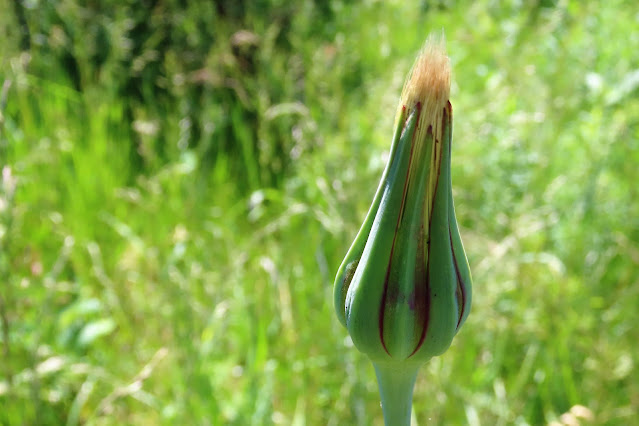






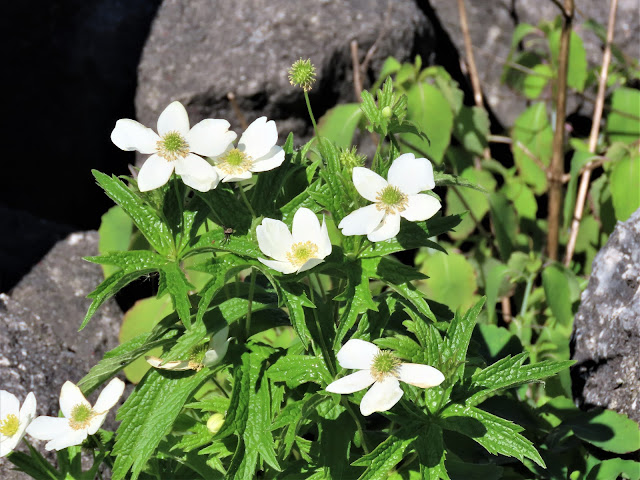










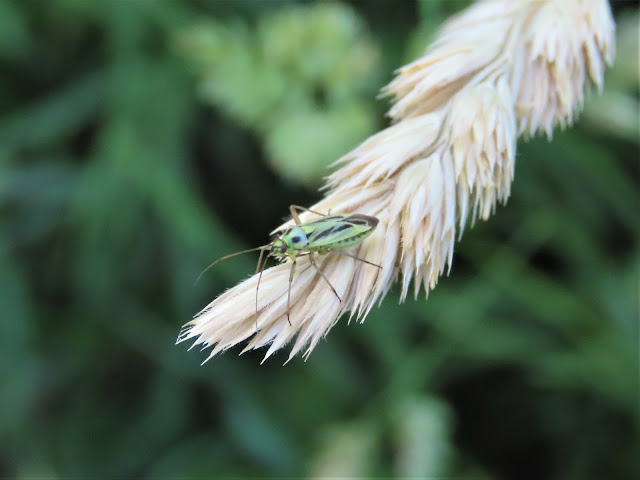

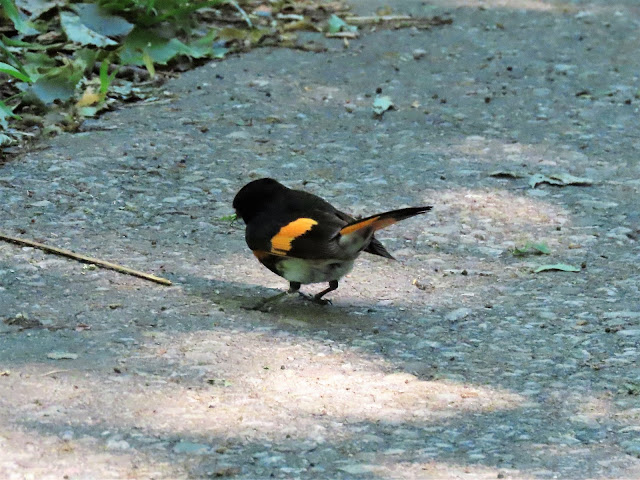






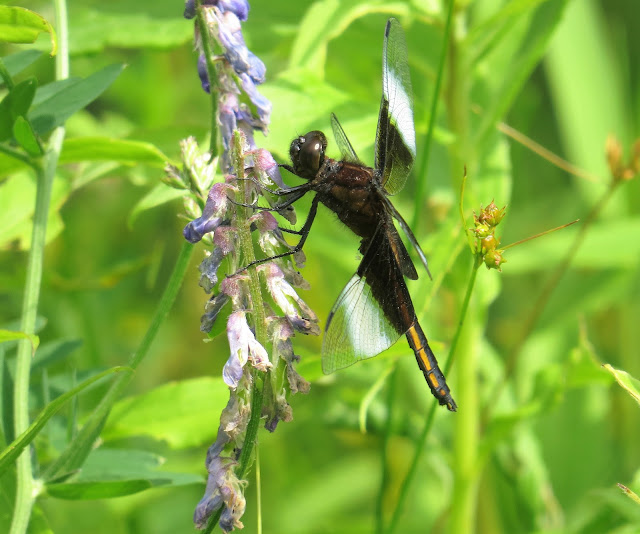











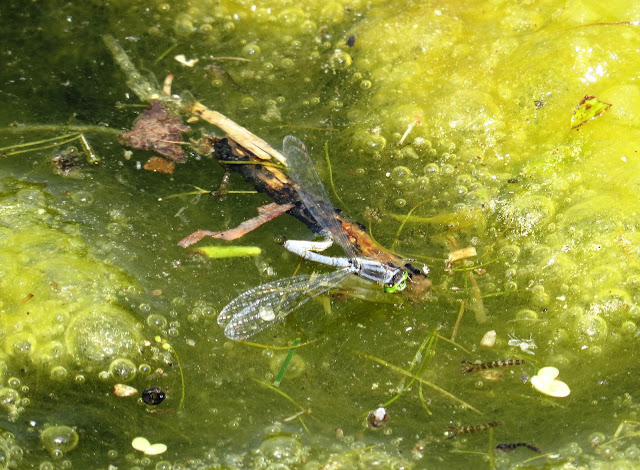











Extremely enjoyable looking through all your photos David. Thank you for sharing them and also identifying all the flowers and wildlife.
ReplyDeleteThank you. Nature is incredibly generous with her bounty for those who are willing to look and I am sure that she would appreciate you sharing the wonder.
ReplyDeletelove to see wild turkey in nature....
ReplyDeletethank you for sharing a lot of beautiful photos....
Hi David, thanks for sharing such a wonderful selection of birds, insects and plants. I know what you mean about not summers being hard to survive, I know that too well! And I am glad you are having success with females in your wanderings! Have a great day, hugs to you and Miriam, Valerie
ReplyDeleteWater lilies look like an ideal picture.
ReplyDeleteSo beautiful. I always enjoy my walks with you.
ReplyDeleteQuerido David que maravillosa entrada nos dejas hoy, me encanta todo lo que en ellas se ve, las plantas, aves e insectos son preciosos. La fotos son espectaculares. La hierba de San Juan también es abundante aquí y florece estos días. Un enorme abrazo para ti y para Miriam.
ReplyDeleteYou are so knowledgeable about so much of nature's offerings. I often saw wild turkeys run across the road and take off when I lived in the country in Illinois. I was afraid I'd hit one.
ReplyDeleteLove,
Janie
Another walk among nature and all its beauty, thanks for sharing.
ReplyDeleteI've never see leafy spurge before. It's really beautiful. You always show new and wonderful things to us, David. And even "old friends" we've seen before look new through your eyes.
ReplyDeleteThanks, Jeanie.
DeleteAnother lovely post sharing a great selection of birds, insects and plants.
ReplyDeleteI enjoyed it, thank you.
All the best Jan
Ooh aah, the beauty of summer in all her forms.
ReplyDeleteThank you, what a lot of flora and fauna.
ReplyDeleteHari OM
ReplyDeletesimply outstanding! YAM xx
I enjoy the succession of blooms this time of year. Butterflies are beyond my photography skills so far. It is sad to see the turtle eggs destroyed.
ReplyDeleteQuite an abundance of life out there.
ReplyDeleteBeautiful birds, insects and flowers David. The wild roses are very pretty.
ReplyDeleteThe plants are lovely when you look at them with more than a fleeting glance, nature is amazing and always continues to amaze. The birds are always a pleasure to see...the header one is good.
ReplyDeleteHello. Fine and varied sightings. Wonderful photos.
ReplyDeleteTake care.
Je reconnais certaines plantes que je vois aussi chez moi. De très jolies photos. Et quand même beaucoup d'oiseaux et des insectes.
ReplyDeleteBonne journée
Captivating photos as always, David.
ReplyDeleteI love these walks with you.
Hi David.
ReplyDeleteSuper series lots of beautiful flowers and birds.
The bird with Lily's haircut is the best.
Greetings from Patricia.
Wildlife in abundance......
ReplyDeleteCongrats on getting the local rarity, of course you would have kicked yourself for not putting the effort in if you had missed it.
On our weekend walks (We both work all week so midweeks walks are almost impossible)Liz takes great interest in the Flora and with my limited knowledge makes for some great time using mr google and such like learning about what we are seeing. A great way to share a hobby.... I still cant quite get her too fascinated with birds. I will keep trying.
A great post David.... a lovely read.
I highly recommend retirement, Dave! Maybe one day you and your special other will make a trip to southern Ontario. There will be lots of nature, a side trip to Niagara Falls, a ramble through Mennonite country, a couple of days in Algonquin Park....and so on. Just let me know when you plan to arrive!!
DeleteOoh you tease 😎
DeleteWell Dave we very well maybe take you up on that offer one day. Very kind
We could reciprocate with sometime in Southern Turkey at some point ( maybe get you a few new birds)
Hi David - well all I can say is ... you've given us amazing photos across a whole spectrum of fascinating species. Brilliant post - thank you. I think Canada has millions+ of wonderful viewing spots for naturalists - hence your area is allowed its space for you and Miriam. Beautiful - cheers Hilary
ReplyDeleteDavid, you showed a lot of dragonflies, so I miss them here - there were a lot of them a few years ago, and now I don't see one day after day. I love the Eastern Kingbird, it's so cute. I am also interested in water lilies, mine still have not flowers.
ReplyDeleteHello David,
ReplyDeleteA wonderful walk with nature, beautiful birds, wildflowers and insects. The leafy spurge is an interesting and pretty plant. Have a happy day!
Enjoyed the IDs of the flowers and dragonflies in this post, David. Too bad your treks to photograph the rare sighting didn’t result in a captured image but you did have the satisfaction of seeing it firsthand.
ReplyDeleteA grand series of photos. I was hoping to photograph dragonflies yesterday but saw very few - there were none at all at the optimistically-named Dragonfly Pond. I can't help but wonder how many hours of human endeavour have been wasted at places called Bittern Viewpoint, Nightingale Wood, the Kingfisher Trail and the like!
ReplyDeleteWonderful photos!!!The observations are fascinating!
ReplyDeleteGreetings Elke
Beautiful nature post, so informative.
ReplyDeleteToday, David, I learned a new word - achene- thank you. As I'm sure you would expect, your dragonflies are the main attraction for me in this blog post. With the esception of the bluets, they all seem far more exotic than most of what we see in UK. I think that the forktail in that last image is ovipositing. A number of UK species oviposit in this way - however, not being familiar with this species, I don't even know that it's a female!
ReplyDeleteThanks for the help with the forktail, Richard, and now that I look at the picture it seems clear that is what is happening!
DeleteDear Friend, buenas noches! I can't even explain how much this entry warms my heart,
ReplyDeleteso splendid. But also want to say that i laughed a lot at the little
bird joke and Lily's old hairstyle, i just burst out laughing! (i hope you can understand what i'm trying to say, i think the sentence is misspelled)
I say goodbye now because tonight the portal of the fairies opens;
we have a party, a very interesting meeting will be; many exciting
adventures will happen between water lilies, Canada flowers,
daisies, roses, dragonflies and the blue bird on the frontis,
he will tell you everything later!
Many kisses and warm hugs since the cold argentine winter.ೋ˚❁ೃೀ ๑ ۩۞۩ ๑ ೃೀ❁ೋ˚
┊┊┊┊
┊┊┊✧
┊┊✦
┊✧
✦
. ✫. ˚ ✦ ·
. + · ·
✹.
✦ ·
. + ·
Me gustara conocer el lugar . Bellas imagenes Te mando un beso
ReplyDeleteEnamorada de las letras
David - I have enjoyed watching the kingbirds at our lake, consuming copious numbers of insects!!! That's a lovely shot of the cinquefoil. So delicate. The oxeye daisy and St. John's Wort are considered invasive around these parts ... but the wild rose is prolific and welcome! I know well the benefits of a fully functioning wetland ecosystem - we have one right in our backyard!
ReplyDeleteI can barely how excited I would be to have my own wetland!
DeleteHi David!!!... very nice pictures of nature... Happy weekend
ReplyDeleteHi David,
ReplyDeletelovely blog with again an abundance of sightings.
What amazes me is, whereas the birds you show are mostly looking different from the ones we see over here (certainly more colorful), the plants and flowers you show look very familiar to me. Most of it grows here too.
Best regards, Corrie
Hello Corrie: The reason that many of the plants look familiar is due to the tendency of early European immigrants to bring with them seeds of their favourite plants from their home countries and establish them here.
DeleteOh, what a feast for the eyes.
ReplyDeleteI have been feeding my neighbour's pigeons for four days, and including fresh water every day, but I have to say that I feel very sorry for them in their enclosure ... Animals belong in the vastness of the landscape, free and independent ... just as we like that . Hug and thank you for your exceptionally wonderful photos.
Greetings Viola
Great to hear from you, Viola. Thanks for stopping by.
DeleteBuenas tardes amigo David, pues para ir solo has hecho un magnífico trabajo que aplaudo. Ya estás hecho un experto botánico amigo mío, nada se te resiste y te desenvuelves como pez en el agua.
ReplyDeleteHa sido todo un placer contemplar tan bello reportaje guiado por tus grandes conocimientos.
Recibe mi más sincero aplauso querido amigo y profesor David, todo un placer leerte.
Te deseo buen resto de semana.
Good job identifying all those dragonflies. We made a project of it here two years ago and failed dismally. It’s hard to get close and they don’t sit still long enough to focus the binoculars. Your common whitetail is so dramatic and I don’t think we have these down here.
ReplyDeleteHallo David,
ReplyDeletePrachtige serie van uiteenlopende soorten die wij hier niet kennen. Bijvoorbeeld de vogels, wat een mooie soorten en wat een prachtige foto in je header. Maar wat ik vooral zo fraai vind zijn de libellen, wat een prachtige soorten zeg, ik heb daar een beetje jaloers naar zitten kijken, echt fantastisch.
Groeten,
Ad
Hi david,
ReplyDeleteNature is amazing. Beautiful birds, insects and flowers. I had never seen the Leafy Spurge (Euphorbia esula), what an interesting and beautiful plant.
All the photos are fantastic but the photos of the insects are superb.
Have a great weekend
So lovely to see some of the glory of summer on our dull dreary winter day :)
ReplyDeleteCuanto aprendemos contigo David. Buen regalo nos dejas. Como me gustaría hacer un paseo contido. Las fotos son un gran canto a la vida. Gracias
ReplyDeleteEl pájaro azul de la cabecera es una belleza.
Buen fin de semana. Cuidaros
Un abrazo.
PS- It's a mustard field.
ReplyDeleteHello David,
ReplyDeleteAnother beautiful nature post, gorgeous flowers, dragonflies and birds. Thank you for linking up and sharing your post. Take care, have a happy weekend. PS, thank you for the info, comment and visit.
So many interesting nature photos.
ReplyDeleteBeautiful photos of birds, insects and flowers, David - nature is amazing.
ReplyDeleteMe encantan esos paseos, yo fotografío todo lo que encuentro, plantas, insectos, aves y paisajes, soy feliz así. Abrazos.
ReplyDeleteHi David :) Jumping for joy at a daily experience in nature qualifies!! :) I have yet to see Wild Turkeys here in this part of NB. I used to see them a lot in the Laurentian mountains where I lived before. The photo of the Cedar Waxwing's "'do" is funny...I've had hair days like that, mostly in the 80's!! Aah you have Rose-breasted Grosbeaks!!! I have yet to see one of those too, and the Evening Grosbeaks have not been around since the spring now. The lily pads are beautiful. Your knowledge of flora is awesome!
ReplyDeleteThank you, I now have my nature fix ... it has been awhile and I truly miss getting out in nature and taking in all the wonder it offers. I see many familiar insects and birds here, and then some I have seen but didn't know what they were until today. Thank you ... I so enjoyed this stroll ...
ReplyDeleteAndrea @ From the Sol
I am glad that I was able to provide your nature fix, Andrea!
DeleteFascinante trabalho fotográfico!
ReplyDeleteAs borboletas fascinam - me!
Continuação de um abençoado final de semana!
Beijinhos!
Megy Maia💛🌻💛
What a nice variety of dragonflies and butterflies. I love the Crescent butterfly. They are so small and dainty. Beautiful photos today!
ReplyDeleteNice close-ups. The colors of the Red-cheeked Cordon-bleu are really nice.
ReplyDeleteI love Anemone canadensis!
We have many of the same species of birds not far from you in Michigan. Our recent view of kingbirds was amusing: they were following our drone, which they didn't seem to like much.
ReplyDeletebest.... mae at maefood.blogspot.com
A lot of humans are not wild about drones either!
DeleteYour close-up photos are impressive!
ReplyDeleteYour post is incredible again... filled with beauty all around you, and captured in photo so well. A great education for us all.
ReplyDeleteEnjoy the day and thank you for taking time to share this with us birders!!
Maravilloso este reportaje, no sólo por sus plantas y flores, algunas de ellas conocidas por mí, como la Potentilla, Leucanthemun, Hipericum perforatum ¡qué bueno saber que son plantas cosmopolitas! también por las aves y me ha fascinado ver las libélulas, la Plathemis no la he visto nunca y me ha parecido bellísima.
ReplyDeleteGracias por este hermoso paseo!
Muchos besos y abrazos.
Sorry I seem to be running late with everything at present but I am trying again to catch up. This is post is fabulous, I love seeing the insects and plants as much as seeing the birds, all new of course to me in your area. Sad about the turtle eggs but I guess nature has to take its course no matter how cruel it can be. With lockdown, I am in fact finding a variation of posts from the norm and I am really enjoying them.
ReplyDeleteI hope all is well and the situation is improving. Very best wishes to you both Diane
Not to worry, Diane. Life sometimes gets in the way, doesn't it?
DeleteSo many comments, I almost feel like mine doesn't matter, but here goes. There's a lot to take in with this post. I always love the birds, because with a cell phone I'm hardly ever able to photograph one. The insects and wildflowers are a bonus I like very much. Rounds out your walks nicely. The bird with Lily's old hairstyle...love it. You are so blessed to live in an area so diverse with wildlife.
ReplyDeleteI am delighted that you took the time to comment, Yvonne. I appreciate it very much.
Deleteo dear, you got a lot in your camera. About most of it I wouldsay, same, but different from ours. Like the Dot-tailed Whiteface, ours are dark red.
ReplyDeleteWaxwings I never see in summer. They are higher up north and only migrates south when there is a shortage of food in late fall/winter.
Thanks for sharing the beauty.
Hello David, as always an interesting post that gives us information of great interest and that makes visiting your blog is always a pleasure. Greetings Julio
ReplyDeleteHello David, I enjoyed this blog a lot. Some great birds, plants and dragonflies. Such delecate creatures.
ReplyDeleteRegards,
Roos
hello David
ReplyDeletelarge selection, the dragonflies are very beautiful, they are not my specialty they are simply too fast and I am too restless ...
Greetings Frank
What a beautiful series you have of all those different types of David.
ReplyDeleteVery nice to see.
Greetings Tinie
...thanks David for sharing your amazing collection of nature's details!
ReplyDeleteImpressive diversity of flora, many of them like Rosa. Leucanthemum and Hypericum grow adventitious in these latitudes. I like dragonflies too. A separate mention for turkeys
ReplyDelete